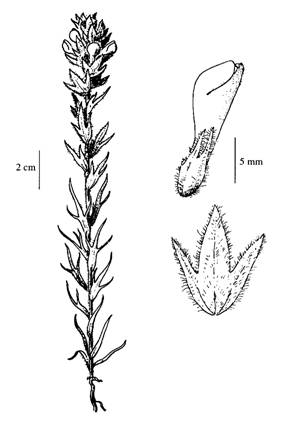Rosy owl-clover (Orthocarpus bracteosus) COSEWIC assessment and status report: chapter 3
Species Information
Name and classification
Scientific name:
Orthocarpus bracteosus Benth.
Synonyms:
none
Common name:
rosy owl-clover
Family:
Scophulariaceae
Major plant group:
Angiospermae (flowering plants)
In the typical variety of Orthocarpus bracteosus plants have rose-purple flowers. Keck (1927) also described variety albus in which the flowers are white. Chuang and Heckard (1992) considered this colour variation to have no taxonomic significance, observing that the two colour forms sometimes grow in close proximity. This may not be strong evidence of genetic identity, however, since Atsatt (1970) observed that two or more species of Orthocarpus often occur on the same site – sometimes separated by microhabitat differences but mostly intermixed as individuals or clusters. This is manifest on Trial Island, where Orthocarpusbracteosus contains both colour forms as well as a large intermixed population of Castilleja ambigua (formerly Orthocarpus castillejoides).
Keck (1927) placed 25 annual species in the subtribe Castillejinae of the genus Orthocarpus. Many of these species have since been re-assigned to Castilleja or Triphysaria leaving nine species in Orthocarpus as it is now constituted (Chuang and Heckard 1991).
Description
A rose-purple annual herb from an erect stem 10-40 cm tall, slender, simple or branched above. Plant is short-hairy and usually purple-tinged. Leaves are alternate, stalkless, linear to lance-shaped and 1.5-3.5 cm long. Leaves have short spreading hairs and sometimes have gland-tipped hairs. The upper part of each leaf is 3-cleft; the upper leaves in the flower head have wide 3-lobed bracts. Flowers are grouped in a dense, prominently bracted (small leaves), densely hairy and glandular terminal spike 3-15 cm long. The bracts are either all green or are purple-tinged in the upper part. Flowers are rose-purple or occasionally white to cream coloured, hairy, 12-20 mm long, exerted from the bracts and tube-shaped. Sepals are tube-shaped, 6-10 mm long, green and glandular-hairy. Fruit is a capsule, elliptical in shape, 5-7 mm long and containing 8 – 15 seeds about 3 mm long (Douglas et al. 2000). Plants of the remaining Canadian population at Trial Island averaged 5 cm tall and reached a maximum of 9 cm in 2001 (pers. obs.). White-flowered plants are not easy to distinguish in vegetative condition but their leaves are less likely to be purplish-tinged so they tend to be paler than foliage of the typical variety (pers. obs.).
Yellow owl-clover (Orthocarpus luteus) is the British Columbia species most closely related to rosy owl-clover. Both have glandular-hairy bracts and calyces, and the upper leaves gradually grade into bracts in both species. Orthocarpus luteus does not occur west of the Coast-Cascade Mountains and its golden-yellow flowers cannot be confused with the rose-purple (occasionally white) flowers of rosy owl-clover (Douglas et al. 2000).
In the field, Orthocarpusbracteosus may be confused with several annuals within the Castillejinae that potentially co-occur with it including: paintbrush owl-clover (Castilleja ambigua), narrow-leaved owl-clover (Castilleja attenuata), dwarf owl-clover (Triphysaria pusilla) and bearded owl-clover (Triphysaria versicolor ssp.versicolor). Members of Triphysaria can be immediately separated when in flower because their anthers are 1-celled and their lower corolla lip is strongly three-pouched. In both Castilleja and Triphysaria the tips of the beak-like upper corolla lips are open and the stigma is expanded, while Orthocarpus has closed tips and a dot-like stigma. Castilleja ambigua, C. attenuata, and Triphysaria versicolor spp. versicolor have white or yellow corollas (sometimes with purple markings and/or fading pinkish) in contrast to the rose-purple corollas typical of O. bracteosus. The red-purple corollas (4-6 mm) of Triphysaria pusilla are much smaller than corollas of O. bracteosus (12-20 mm) (Douglas et al. 2000).
Figure 1. Illustration of Orthocarpus bracteosus (Illustration by J.R. Janish from Hitchcock and Cronquist 1973, with permission).
